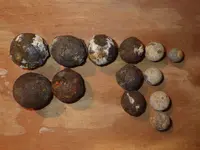There are two tests to determine if a lead ball is a musketball/pistolball:
1- Unfired ones are "perfectly round," like a glass marble, except for sometimes showing a casting-mold sprue, and/or a very tiny raised moldseam line around their "equator." (If a musketball/pistolball wasn't perfectly-round, it would tend to jam in the gunbarrel during loading or firing -- which is very bad news in combat.)
2- A super-precise measuring test (done with a Digital Caliper) is needed, because hundredths-of-of-an-inch are extremely important in bullet sizes. For example, if a ball measures .77-inch, it is definitely not a musketball because it doesn't match up with any known caliber of musket.
Very important point:
Until approximately the 1830s/40s, all firearms were the muzzle-loader type, which means the bullet was loaded from the gunbarrel's front end. Therefore, the bullet HAD to be a few hundredths-of-an-inch smaller than the gun's bore-diameter. For example, the Colonial-era British "Brown Bess" musket was .75-caliber (which means its bore diameter was .75-inch), and the musketballs for it were .71 or .72-inch in diameter.
Speaking of sizes... the largest caliber of all the "Historical" muskets was .85-caliber. So, lead balls which are bigger than .82-inch cannot be a musketball.
About your out-of-round lead balls... they might have been firearms balls which were perfectly-round but are fired ones which got "bent" by impacting against something at high speed. But there's no way to know for certain whether they are fired projectiles or some other kind of lead ball. Generally, fired musketballs/pistolballs will show a "smash" on them instead of just being out-of-round (kinda oval-shaped).
Some of your lead balls which you report as being 1-inch, 1.25-inches, and 1.75-inches might be from what is called "Quilted Grapeshot," which was a sort of shotgun ammo for cannons in the Colonial era through the 1840s. (Afterward, Quilted Grapeshot was replaced by what is called Canister, whose "giant buckshot" balls were contained in a sheetmetal can instead of a cloth bag.)
In summary:
Please remove the dirt-crust from any of your lead balls which are perfectly-round, and measure their diameter with a Digital Caliper. Then post the measurement in hundredths-of-an-inch, so I can tell you if there is a matchup for them in the known sizes of musketballs and pistolballs. (For example, if the one you said is 3/4-inch (.75-inch) actually measures .72 inch, it is a musketball for the 1700s-to-early-1800s British "Brown Bess" caliber musket. But as noted above, if after cleaning it measures (let's say) .73-inch to .80-inch, it cannot be a musketball.





 I 'm not the expert you seek- that would be cannonball guy and he will know. HH
I 'm not the expert you seek- that would be cannonball guy and he will know. HH